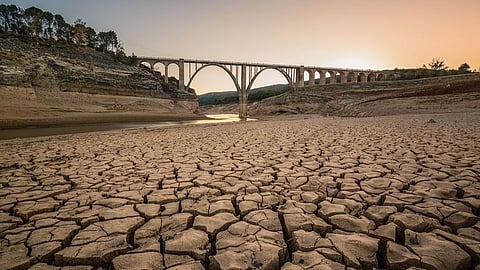

Droughts intensified by global heating have driven a wave of mass wildlife deaths across Africa and the Amazon, with starvation, heat stress and human culling decimating animal populations between 2023 and 2025, a new United Nations report warns.
Droughts had both direct and indirect consequences on wild animals, according to the Drought Hotspots Around the World 2023-2025, published on July 2, 2025 by the US National Drought Mitigation Center and the UN Convention to Combat Desertification (UNCCD), with support from the International Drought Resilience Alliance. Many may have died of starvation, while others were culled by humans attempting to cope with the impacts of the crisis.
During 2023 and 2024, southern and eastern Africa experienced a rise in human-wildlife conflict, the slaughter of wildlife for food and large-scale wildlife deaths driven by extreme dry conditions, the report noted.
The global drought between 2023 and 2024 was influenced by the climate phenomenon El Niño-Southern Oscillation (ENSO). A spike in global temperatures occurred in 2023, which one study attributed to the El Niño event active at the time, the report said. El Niño and La Niña are opposite phases of ENSO that affect global weather and climate systems.
An instance of human-wildlife conflict occurred in June 2023 in Kenya, when six lions were speared to death in a revenge attack after they killed livestock.
“Lions from the Amboseli National Park had wandered into a nearby farm seeking food and killed 12 goats. The Maasai owner of the goats stated that losing half of his herd was a substantial loss of income and compensation from the Big Life Foundation conservation programme would not be enough to replace them. Other locals had also lost goats to lion killings,” the report said.
This incident was tied to drought conditions: The Maasai community, known for co-existing peacefully with lions and other wild animals for generations, found themselves in conflict as a result of extreme ecological stress driving predators towards human settlements.
Similarly, Hwange National Park in Zimbabwe experienced severe drought in the early summer of 2023-24, resulting in the deaths of at least 100 elephants due to starvation and lack of water. Some elephants died after becoming trapped in muddy water holes while trying to access water.
In September 2024, Zimbabwe and Namibia announced plans to cull unsustainably large wildlife populations to feed needy communities. Representatives from the Zimbabwe National Parks and Wildlife Management Authority said they would allow the hunting of 200 elephants, citing that the Hwange elephant population was over three times the sustainable limit, according to the report.
With an estimated 100,000 elephants, Zimbabwe’s population was at risk of mass starvation and dehydration as the summer months began. Namibia’s culling plans included 83 elephants, 300 zebra, 100 eland, 60 buffalo, 50 impala and 30 hippos, among other animals across five national parks, the report said.
In April 2024, an entire herd of hippos reportedly became stuck in the mud as Botswana’s Thamalakane River dried up due to prolonged drought. The number of wild animals that perished while trying to access water or escape the extreme heat remains unknown, it added.
Authorities were forced to relocate the hippos from the area near the tourist town of Maun to prevent further human-wildlife conflict, as hippos are known to become aggressive when water is scarce.
In neighbouring Zimbabwe, 19 hippos reportedly died over a three-month period. An investigation confirmed that starvation caused by drought was the cause of death. The report noted that the animals were in poor health and showed signs of malnutrition, with no other unusual conditions observed.
In the Amazon basin, low water levels during the droughts had a significant impact on aquatic life. In September 2023, over 200 endangered Amazonian river dolphins and thousands of fish died within days in Lake Tefé as water temperatures soared well beyond the animals’ thermal limits.
Temperatures in the lake had reached as high as 39°C, the report noted. A similar die-off occurred in September 2024, with juvenile dolphins found dead along the lake’s shores as water levels dropped and temperatures rose again.
In the long term, such events are expected to alter the species composition and functional types of fish in the Amazon basin, a pattern previously observed following the short, intense drought in the region in 2005.
Extreme droughts in 2024 also left native Amazonian manatees exposed to poachers. These animals, often called “sea cows”, typically stay submerged in tropical Atlantic waters, but receding river levels forced them into the open.
“Manatee poaching was outlawed in Brazil in 1967, but the meat is still commonly consumed in small Amazonian towns. Law enforcement and changing cultural perceptions of manatee meat have reduced the incidence of poaching and helped restore manatee populations, but the species is still vulnerable and the ease of poaching during drought threatens their numbers,” the report said.